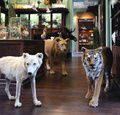If you thought Teddy Ruxpin, the 1980s animatronic talking teddy bear, was creepy, you haven’t seen anything yet. According to reports, Fujitsu is working on a line of “Social Robot” teddy bears that are not only animated, they change their behavior based their interactions with humans. This video shows the bear in action. Depending on your cues, these cute-as-a-button bears will chose an appropriate response from hundreds of programmed behaviors—from laughing to waving to wiggling their feet.
Here at Collectors Weekly, we know this concept is nothing new in Japan. In fact, we just launched a new category detailing the surprising history of toy robots.
As our Overview points out, the first automatons were created by a Japanese craftsman named Hisashige Tanaka in the Edo period. Known as karakuri dolls, these beautiful creations could be startlingly life-like, and Japanese aristocrats were delighted by their ability to serve tea, shoot arrows, and write.
Western culture, on the other hand, has remained generally fearful of artificial intelligence, with visions of sentient robots turning violent and taking over the world. The roots of the West’s robot paranoia can be traced to Czech writer Karel Capek’s 1920 play, “R.U.R.” or “Rossum’s Universal Robots,” in which robots wipe out our species. Hello, Cylons?
But in Japan, particularly in the wake of the nuclear bombs dropped on Hiroshima and Nagasaki in World War II, robots were seen as the most trusted allies a person could have. For example, Ozamu Tezuka’s 1951 manga hero, Astro Boy, an adorable humanoid robot with an atomic-powered body and laser fingers, fights for humanity with all the earnest integrity of Superman. In other animes, remote-control giant robots or “mecha” gave little-boy Davids their own Goliaths to take down enemies.
Even all those classic metal robots from the ’50s and ’60s, with their moving arms and light-up eyes, were as well loved in Japan as the ragtag vintage teddy bears found in American antiques malls today. It only makes sense, then, that in Japan, robots and teddy bears would become one and the same.
(Bear image: Fujitsu, robot images: Metal House)


 Can't Buy Me Love: How Romance Wrecked Traditional Marriage
Can't Buy Me Love: How Romance Wrecked Traditional Marriage Taxidermy Comes Alive! On the Web, the Silver Screen, and in Your Living Room
Taxidermy Comes Alive! On the Web, the Silver Screen, and in Your Living Room Our Dad, the Water Witch of Wyoming
Our Dad, the Water Witch of Wyoming Teddy BearsTeddy bears are among the most cuddled and beloved of childhood companions,…
Teddy BearsTeddy bears are among the most cuddled and beloved of childhood companions,… RobotsThe 1950s was a particularly good decade to be a toy robot. The world was g…
RobotsThe 1950s was a particularly good decade to be a toy robot. The world was g… Mari Tepper: Laying it on the Line
Mari Tepper: Laying it on the Line Nice Ice: Valerie Hammond on the Genteel Charm of Vintage Canadian Costume Jewelry
Nice Ice: Valerie Hammond on the Genteel Charm of Vintage Canadian Costume Jewelry How Jim Heimann Got Crazy for California Architecture
How Jim Heimann Got Crazy for California Architecture Modernist Man: Jock Peters May Be the Most Influential Architect You've Never Heard Of
Modernist Man: Jock Peters May Be the Most Influential Architect You've Never Heard Of Meet Cute: Were Kokeshi Dolls the Models for Hello Kitty, Pokemon, and Be@rbrick?
Meet Cute: Were Kokeshi Dolls the Models for Hello Kitty, Pokemon, and Be@rbrick? When the King of Comedy Posters Set His Surreal Sights on the World of Rock 'n' Roll
When the King of Comedy Posters Set His Surreal Sights on the World of Rock 'n' Roll How One Artist Makes New Art From Old Coloring Books and Found Photos
How One Artist Makes New Art From Old Coloring Books and Found Photos Say Cheese! How Bad Photography Has Changed Our Definition of Good Pictures
Say Cheese! How Bad Photography Has Changed Our Definition of Good Pictures Middle Earthenware: One Family's Quest to Reclaim Its Place in British Pottery History
Middle Earthenware: One Family's Quest to Reclaim Its Place in British Pottery History Fancy Fowl: How an Evil Sea Captain and a Beloved Queen Made the World Crave KFC
Fancy Fowl: How an Evil Sea Captain and a Beloved Queen Made the World Crave KFC
Leave a Comment or Ask a Question
If you want to identify an item, try posting it in our Show & Tell gallery.